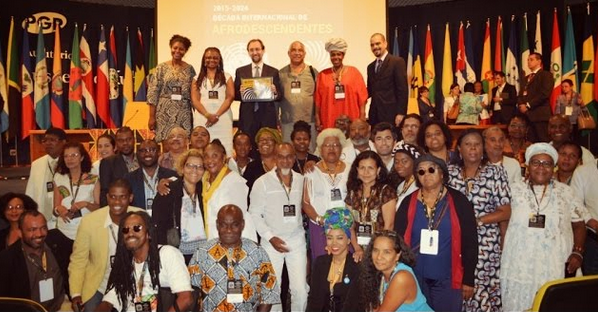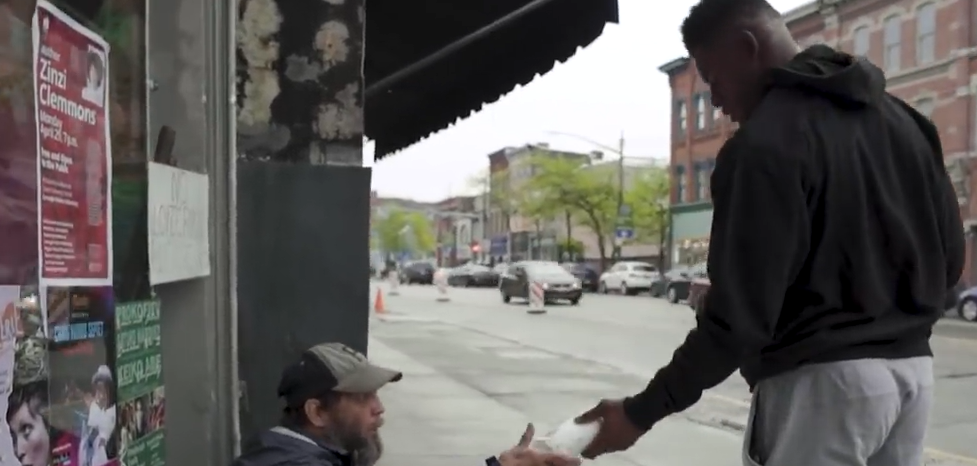Photos: YouTube
During summer 2020, the murders of George Floyd, Breonna Taylor, and too many other Black Americans sparked a national dialogue around the failings of the U.S. criminal justice system.
People nationwide joined together in protest of police violence, calling for a new approach to safety and justice. During this crucial moment, the Center for American Progress, the John Jay College of Criminal Justice, and the Draper Richards Kaplan Foundation virtually gathered 1,000 advocates, researchers, artists, and practitioners for the Innovations Conference, a multiday exploration of what it means to reimagine public safety and shrink the footprint of the justice system.
In the months that followed, public protests, spirited discussions, and grassroots campaigns led to remarkable policy changes across the country. Although the work is far from done, the movement has tangibly reshaped the nation’s approach to justice and safety, offering a powerful example of community activism and civic engagement in action.
The sections below break down five major issues that have shaped the national conversation around safety and justice, weaving in voices from the Innovations Conference to provide a snapshot of the country’s progress to date and the pathway forward.
1. Investing in safety beyond policing
In most American cities, police department appropriations make up a significant portion of local budgets. Yet communities need more than just investments in policing, a fact that police officers themselves have acknowledged. Investments in community-building resources—including high-quality health care, child care and education, access to affordable housing, and other supportive services—are integral to building safer and stronger neighborhoods.
As more and more Americans call for investments in safety beyond policing, local lawmakers have started to shift resources toward social supports and nonpunitive strategies, such as civilian first-responder programs and violence intervention models. And many cities are establishing offices within local government that are dedicated specifically to community-building solutions. Examples include:
Albuquerque, New Mexico. In June 2020, Mayor Tim Keller (D) announced plans to create the Albuquerque Community Safety Department, a new branch of civilian first responders that provides an alternative to police response for 911 calls related to certain types of nonviolent issues.
Austin, Texas. In August 2020, the Austin City Council voted to reinvest a portion of the city’s police budget into a range of services aimed at preventing violence, boosting employment outcomes, alleviating chronic homelessness, protecting victims of family violence, and responding to COVID-19.
Baltimore. In December 2020, the city of Baltimore established the Mayor’s Office of Neighborhood Safety and Engagement, which is charged with implementing a holistic approach to strengthening safety and addressing the impact of violence and trauma within the community.
Minneapolis. In August 2020, with additional funding from the Minneapolis City Council, the Minneapolis Office of Violence Prevention announced the hiring of street outreach workers—known as “violence interrupters”—to detect and de-escalate conflicts before they turn violent.
San Francisco. In November 2020, Mayor London Breed (D) launched the Street Crisis Response Team, which sends trained, unarmed professionals in lieu of police to respond to 911 calls involving mental health and substance misuse concerns.
Seattle. In its 2021 budget, the city of Seattle prioritized investments in community safety and well-being, including by expanding tiny house villages and other services for unhoused people, providing appropriate responses to behavioral health crises, revitalizing parks and other community green spaces, and launching initiatives to combat racial inequality within the city.
2. Promoting police accountability
American police have significant leeway to use force against civilians, yet officers are rarely held accountable for the harmful—and, in some cases, deadly—consequences of their actions. In recent months, the need for increased police accountability has sparked protests and dominated headlines following a spate of high-profile incidents of police violence against the Black community. Policymakers have begun answering calls to overhaul policing practices, including by establishing use-of-force guidance to proactively prevent misconduct and creating processes to hold officers accountable when misconduct occurs. Voters approved dozens of police reform measures in the November 2020 election, and additional ballot measures are already in the works for local elections in 2021.
While it’s still too early to assess the impacts of these newly enacted measures, there is promising evidence emerging from police departments that are farther down the path to reform. For example, the Newark, New Jersey, Police Department began implementing a package of comprehensive police reforms in 2016 after a U.S. Department of Justice investigation found systemic officer misconduct within the department, including biased policing practices and excessive use of force. After overhauling use-of-force guidelines and mandating intensive de-escalation trainings for officers, the Newark police “did not fire a single shot” during the entirety of 2020. Examples of other reforms include:
Akron, Ohio. In November 2020, voters in Akron approved Issue 2, a ballot initiative that requires law enforcement agencies to release body and dashboard camera footage following use of force that results in death or serious harm.
Colorado. In June 2020, Gov. Jared Polis (D) signed S. 217 into law, which changes guidelines around police use of force and requires law enforcement agencies to collect and report data—such as racial data on officers’ encounters with the public—to the state.
Illinois. The state of Illinois enacted a sweeping criminal justice reform law in February 2021 that sets a statewide standard for use of force, empowers the state attorney general to investigate unconstitutional policing practices, and creates a process for decertifying police officers who engage in misconduct. The bill also expands a database that tracks officer misconduct and prevents law enforcement agencies from destroying officer misconduct records, purchasing certain types of military equipment, or using chokeholds.
New York. In June 2020, Gov. Andrew Cuomo (D) signed into law the “Say Their Name” Reform Agenda package, which permits the disclosure of officers’ prior disciplinary records and designates the New York attorney general as an independent prosecutor for matters relating to civilian deaths.
Philadelphia. This past Election Day, Philadelphia residents approved Question 3, a ballot initiative that will replace the city’s Police Advisory Commission with a Citizens Police Oversight Commission, granting it greater authority to investigate police misconduct.
Virginia. In October 2020, Gov. Ralph Northam (D) signed into law a bill that allows the state attorney general to conduct pattern-or-practice investigations of police misconduct.
3. Ending unjust punishments
Policymakers across the political spectrum have renounced the war on drugs, a punitive policy agenda that has exacerbated mass incarceration by imposing excessive punishments for substance use, particularly for communities of color. Yet in 2019, law enforcement agencies still made more than 1.5 million drug-related arrests, more than 30 percent of which were for possession of marijuana. These statistics hide stark racial disparities in drug enforcement: Despite roughly equal usage rates, Black Americans are nearly four times more likely to be arrested for marijuana possession and six times more likely to be incarcerated for drug charges than their white counterparts.
Promisingly, jurisdictions across the country are taking action to reverse the harsh penalties of the war on drugs, including 15 states that have legalized recreational marijuana. However, the conversation around unduly severe punishments cannot be limited to low-level, nonviolent offenses. Dismantling mass incarceration will require stakeholders to reevaluate sentencing practices and challenge excessive punishments for all offenses—even serious ones. Jurisdictions across the nation have begun this important work, eliminating unjust punishments and adjusting sentence lengths to ensure that every offense is met with a fair and proportional response. Examples include:
Athens, Georgia. Newly elected District Attorney Deborah Gonzalez (D) is using her prosecutorial discretion to address unduly harsh punishments by instructing her office to limit charges that trigger mandatory minimum sentences, decline prosecutions for marijuana possession, and cut back on charges for low-level drug offenses and probation violations.
Oregon. The state of Oregon adopted a public health approach to addressing substance use after voters approved a ballot measure to decriminalize personal possession of small amounts of all drugs. Starting in February 2021, people in possession of drugs will be offered treatment and recovery services, rather than prison time.
Nationwide. Lawmakers in Louisiana, Ohio, and Virginia eliminated life without parole sentences for people under age 18, while Washington, D.C., adopted a law allowing individuals incarcerated for crimes committed while under age 25 to apply for a sentence reduction after serving 15 years in prison.
4. Eliminating racial disparities across the justice system
Racial disparities pervade every stage of the American criminal justice system, from police stops to arrest rates to sentencing decisions and beyond. For instance, African-Americans are more likely than their white counterparts to be arrested, convicted, and given longer sentences for the same offense. Moreover, amid the COVID-19 public health crisis the incarcerated population—disproportionately comprised of communities of color—faces a heightened risk of contracting the coronavirus, given the confined nature of correctional facilities.
While more must be done, some jurisdictions have taken key steps to protect incarcerated individuals and reduce overcrowding behind bars, including by curtailing pretrial detention, expanding early release options, and pursuing other reforms that can be sustained even once the pandemic has subsided. Other jurisdictions are directly confronting racial disparities in policing by calling for an end to practices that target communities of color, such as stop and frisk. And importantly, policymakers are looking upstream to disrupt systems that contribute to disparities within the justice system. Many localities are starting to remove police officers from schools in an effort to disrupt the school-to-prison pipeline—the practice of pushing students out of educational systems and into the justice system, which disproportionately criminalizes young people of color for disciplinary violations at school. Examples of all the above include:
Fremont, California. In November 2020, the Fremont Unified School District board voted to remove police resource officers from all of the district’s high schools.
California. To combat systemic racism within the justice system, the state of California enacted a package of bills in September 2020 that will address discriminatory practices within jury selection, prohibit prosecutors from seeking convictions or sentences on the basis of defendants’ race or ethnicity, and lay the groundwork for reparations for the Black community.
New Jersey. In October 2020, Gov. Phil Murphy (D) signed into law a bill allowing incarcerated people with less than a year left on their sentences to be released up to eight months early for the duration of the COVID-19 public health emergency. The effort is intended to mitigate harm within New Jersey’s prison system, which had the nation’s worst racial disparities in incarceration rates and the highest rates of COVID-19 deaths behind bars as of November 2020.
Philadelphia. In November 2020, voters in Philadelphia approved a ballot measure that adds language to the city charter calling on the police department to eliminate unconstitutional stop-and-frisk actions.
Portland, Maine. In November 2020, voters approved a ballot measure that bans the use of facial recognition technology by the police and other public agencies or businesses.
5. Removing barriers facing individuals affected by the justice system
After decades of overcriminalization, nearly 5 million Americans have spent time in prison, and upward of 77 million Americans have some sort of criminal record. Individuals affected by the criminal justice system face immense barriers, even after serving their sentences. Within state and federal laws and regulations, there are roughly 45,000 “collateral consequences” that disqualify people with criminal records from voting, obtaining business or occupational licenses, accessing employment and housing, receiving public assistance, and participating in other key elements of civic life. This vast network of collateral consequences has disenfranchised 5.2 million Americans and contributed to staggering rates of unemployment and housing insecurity among formerly incarcerated individuals.
All too often, policymakers have marginalized the voices of these affected communities, whose firsthand experiences with the justice system are invaluable to the national conversation around reform. Over the past few months, however, jurisdictions have adopted a range of policies to break down barriers facing these communities—from expanding reentry services and voting rights to issuing pardons and sealing old criminal records to provide people with a clean slate. Many of these reforms were driven by justice-involved advocates, whose leadership and expertise must be at the center of the national movement to shrink the criminal justice system. Examples include:
California. In November 2020, following a successful campaign led by justice-involved organizers, voters in California approved a constitutional amendment to restore the right to vote for people who have felony convictions and are on parole.
Colorado. In October 2020, Gov. Polis pardoned more than 2,700 people convicted of possession of an ounce of marijuana or less.
Dallas. For its fiscal year 2020–2021 budget, the city of Dallas boosted investments in reentry services to expand access to housing, job skills trainings, and wraparound supports for formerly incarcerated residents.
Michigan. In September 2020, Michigan enacted a law that will automatically expunge certain criminal records after seven years, providing a fresh start for hundreds of thousands of people. The “Clean Slate” law was championed by a coalition of advocates representing both formerly incarcerated individuals and survivors of crime.
Conclusion
The 2020 Innovations Conference came in the midst of a national conversation on shrinking the footprint of the criminal justice system. In the following months, protestors, advocates, and policymakers across the country have actualized many of the transformative ideas that came out of such discussions. Recent investments in community-based solutions, for example, reflect a more effective approach to public safety than the traditional overreliance on law enforcement. Furthermore, jurisdictions have enacted policies to disrupt the pipelines to incarceration, promote police accountability, and deprioritize criminalization, responding to calls for reducing the footprint of the system on the front end. On the other end, several measures have been taken to address the racially disparate impact of mass incarceration and barriers facing affected individuals.
While these are promising steps, more must be done to scale back a system deeply entrenched in systematic racism. Stakeholders must continue to build on the progress that has been made during this historically momentous period in the criminal justice reform movement.
Kenny Lo is a research associate for Criminal Justice Reform at the Center for American Progress. Sarah Figgatt is a research associate for Criminal Justice Reform at the Center. Betsy Pearl is the associate director for Criminal Justice Reform at the Center. Chelsea Parsons is the vice president for Gun Violence Prevention at the Center.








